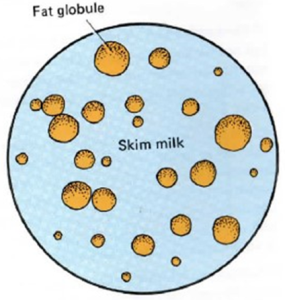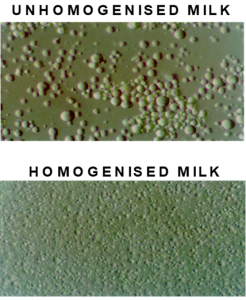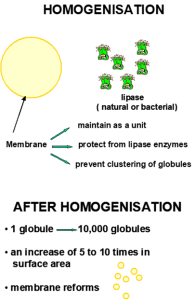Background
Homogenisation of milk has been around since its invention by Auguste Gaulin in the very early 1900s We all know that if you leave non-homogenised milk to stand still, the cream will rise to the surface. The milk and the cream separate. It does this because the cream is lighter than the milk.
Many milk types are available from shops and supermarkets, but many are not ideal for making cheese. To make cheese, you require pasteurised, not homogenised, milk (milk where the cream floats to the top of the bottle). The label will usually mention that the milk is homogenised or non-homogenised.
There is a common misconception that all goat’s milk is homogenised. Goat milk naturally has smaller fat globules than cow’s milk, so they do not readily rise to the surface. The goat’s milk cream that does rise to the surface is also white, so it is not easily visible without looking closely. A brand of goat milk is available from supermarkets, but it is homogenised, and the soft, fragile curd does not usually make great cheese.
Raw milk is not pasteurised, and it is not homogenised.

The homogenisation process
The main reason milk is homogenised is to prevent the fat globules from rising to the surface of the milk. This fat globule movement happens in both raw milk and pasteurised non-homogenized milk. The fat globules are temporarily dispersed if fresh milk is shaken or stirred. But almost instantaneously, the fat starts to rise to the surface. If the milk is left to stand for a few days, those fat globules eventually clump together, forming a layer of cream that is almost impossible to separate.
The milk to be homogenised is heated to approximately 50 °C. The milk is then delivered to the homogeniser by a standard centrifugal milk pump. The homogeniser is a second pump in the process. It is a positive displacement pump, which applies pressures of 2,000 psi up to 6,000 psi to the milk flow to force the milk through a homogenising valve assembly, which is basically two flat abrasive discs clamped together. As the milk is forced through this micro gap, it causes the fat globule membrane to break open, and the fat globules are broken into thousands of smaller fat particles. It is now, because of the lower specific gravity of the smaller fat particles, that they can no longer rise to the milk’s surface.

Microscopic view of unhomogenised milk and homogenised milk
The average diameter of fat globules in non-homogenised milk is about 6 microns. (1 micron is equal to one ten thousandths of a centimetre), Homogenised milk has fat globules of approximately I micron in diameter. The fat globules in homogenised milk are about 10,000 times greater than in unhomogenised milk. Consequently, the total interface area between fat globules and milk scrum is increased by a factor of 10
The effect of using non-homogenized milk to make cheese
Several differences occur when making cheese with homogenised and non-homogenised milk:
- Different rates of acid development between homogenised and non-homogenized milk
- Shorted rennet coagulation time (benefit)
- Slower draining of the curd
- Decreased yields
- Decline in the colour of the cheese
- Increase in the flavour of the cheese because of fat breakdown (benefit)
- poor fusion of hard-pressed styles of cheese
- poor stretching and melting for mozzarella styles
The main reason homogenised milk is not used to make cheese is because of the inferior curd-forming properties of homogenised milk. Homogenised milk curd has decreased elasticity, and the curd shatters easily during the stirring step and any subsequent curd handling step, such as hooping.
The weaker curd is attributed to two main areas: the increase in the number of smaller fat particles in the curd and the decreased number of casein fibres needed to form a curd.

Figure 2: Formation of New Membrane
Other solutions
There are a few minor exceptions where you can use homogenised milk to make cheese. In some more extensive commercial cheesemaking operations, it is desirable to separate the cream from the milk, homogenise that cream portion, and then re-add that cream back into the milk. The extra fat breakdown and the ‘white’ colour of the finished cheese are desirable in blue vein cheese.
Some alternatives are promoted to allow homogenised milk to be used to make cheese, but all of these options still produce inferior quality cheese. These include adding calcium chloride to the milk, increasing rennet volume, reducing the cut size, and increasing the milk temperature before rennet addition.
Homogenised milk at 50:50 homogenised:non-homogenised, can be used successfully to make gourmet feta because it requires a soft curd. You may successfully make lactic acid set cheeses using homogenised milk however the curd is still very fragile. Cheeses such as cream cheese and fromage blanc may also work reasonably well as will milk ricotta.
Yoghurt will work very well with homogenised milk.
Conclusion
Using non-homogenised milk is your best option if you want to make cheese. The freshest non-homogenised milk that you can get. Commercial manufacturers around the world use only non-homogenised milk to make cheese. Homogenised milk works to a small extent, but it makes an inferior cheese and yields less. If you are being told to add calcium chloride to homogenised milk, you will still use significantly inferior milk and get an inferior cheese.



